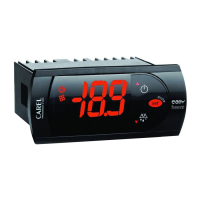22
ENG
easy/easy compact/easy split +030220791 - rel. 3.2 - 13.07.2010
dC: time base
Used to modify the unit of measure used to count the times for parameters
dI (defrost interval) and dP (defrost duration).
The following values are available:
dC dI dP
0 hours minutes
1 minutes seconds
Table 4.g
The parameter dC=1 can be useful to:
• test the operation of the defrost function with reduced times;
• manage air driers. The defrost cycle thus becomes the condensate
drain cycle, which must occur at close intervals (minutes) and for very
brief durations (seconds).
Important: this parameter should not be used (dC= 1) if the
defrost requires the activation of the compressor (hot gas) and
when d9=1, as otherwise the compressor may be damaged due to a
number high of consecutive starts.
4.8 Alarm parameters
The alarms can be set as regards the threshold, type and activation
delays.
When an alarm occurs, the unit may stop normal operation and warn that
the alarm situation has occurred, based on the type of alarm.
A0: alarm and fan temperature di erential
This represents the di erential used to activate the high and low
temperature alarms (“AH”, “AL”) and for the management of the fan.
In the event of an alarm, as seen in the gure, the value of “A0” determines
the actual activation of the temperature alarms.
The value of “A0” (negative or positive) de nes the nature of alarms “AL”
and “AH” (absolute or relative, respectively), in detail:
A0≤ 0 AL and AH expressed as absolutes
A0> 0 AL and AH expressed relative to the set point (St or St + r4 in
night-time operation)
set point
A0 A0
AHAL
1 2
Fig. 4.j
Key:
1 low temperature alarm;
2 high temperature alarm.
AL: absolute or relative temperature for low temperature alarm
Determines the activation threshold of the low temperature alarm.
AL Low temperature
alarm (normal) if...
Low temperature
alarm (night-time)
if...
Alarm disabled
if...
absolute temp. probe 1 ≤ AL temp. probe 1 ≤ AL AL= -50
relative temp. probe 1 ≤
St - AL
temp. probe 1 ≤ St +
r4 - AL
AL= 0
Table 4.h
AH: absolute or relative temperature for high temperature alarm
Determines the activation threshold of the high temperature alarm.
AHHigh temperature
alarm (normal) if...
High temperature
alarm (night-time)
if...
Alarm disabled
if...
absolute temp. probe 1 ≥ AH temp. probe 1 ≥ AH AH= 150
relative Temp. probe 1 ≥ St
+ AH
temp. probe 1 ≥ St +
r4 + AH
AH= 0
Table 4.i
Note: the low and high temperature alarms are automatically
reset - this means that if the temperature returns within the
allowed range, the alarm signal is automatically cancelled. During a high
or low temperature alarm, the message “HI” or “LO”, respectively, ashes on
the display alternating with the temperature; if tted, the buzzer is
activated.
Ad: temperature alarm delay
Indicates after how many minutes the temperature alarm is signalled from
when it is detected. If the temperature, after the delay Ad, is within the
allowed limits, the alarm is not signalled. Setting a delay to signal of the
temperature alarms may help eliminate false alarms due to interference
on the probe signal or situations lasting a short time (for example,
opening the cold room door brie y). The temperature alarm delay has
no e ect on two special functions: defrost and continuous cycle. To delay
any temperature alarms after these functions, parameter d8 for defrost
and c6 for continuous cycle must be modi ed. Remember that during
defrost and continuous cycle no temperature alarms are generated.
Def.: Ad=0 (instant temperature alarm).
A4: 3rd input con guration (easy compact)
The multifunction input is only available on the easy models with three
inputs; is not available on the easy compact models.
This parameter is used to set the functions of the input.
easy, easy compact
A4 Meaning
0 Input not active
1 External alarm: instant (A7= 0) or delayed (A7>0)
Input open= alarm
Input closed= ok
2 Enable defrost
Input open= disabled
Input closed= enabled
3 Start defrost when closing
MODEL M: select probe displayed
Input open= probe 1
Input closed= probe 2
4 Curtain switch or night-time operation
Input open= normal set point
Input closed= night-time set point [r4]
5 Remote ON – OFF
Input open= OFF
Input closed= ON
6 Direct operation of AUX output when H1= 3
Input open= AUX de-energised
Input closed= AUX energised
7 Door switch with evaporator fans o
‘dor’ alarm: - instant (A7= 0) or delayed (A7>0)
- operation of AUX output (H1= 3)
Input open= door open
Input closed= door closed
8 Door switch with evaporator fans and compressor o
‘dor’ alarm: - instant (A7= 0) or delayed (A7>0)
- operation of AUX output (H1= 3)
Input open= door open
Input closed= door closed
9 Direct / reverse operating mode
IF r3 = 0 input open= direct + defrost
input closed= reverse
IF r3 = 1 / 2 input open= direct
input closed= reverse
10 Probe for dirty condenser alarm
11 Product probe
Table 4.j

